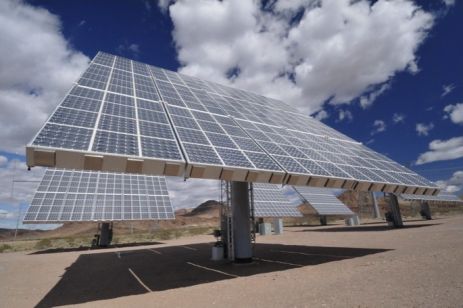I’m waving the green flag of surrender, crushed by the organic cotton-gloved fist of the enviro-public relations-industrial complex.
I will write an Earth Day column, my resistance broken by the ceaseless pitches from corporate PR people to include “in your Earth Day coverage” everything from how to “go green between the sheets [and] make your love life sustainable,” to a certain multinational beverage company’s LEED-certified bottling plant, to a defense contactor’s environmental initiatives.
It just won’t be a column about any of those things.
As I fruitlessly explained to those who wouldn’t take their deleted pitches and unanswered phone calls as a sign of my lack of interest, every day is Earth Day for environmental reporters.
 Photo courtesy of AmonixSo I’m going to write about something that in the pre-blog era was known as news. On Earth Day eve, a Southern California solar company called Amonix announced that it had raised $129.4 million from a group of investors led by Kleiner Perkins Caufield & Byers, one of Silicon Valley’s most prominent venture capital firms and a leading green tech investor.
Photo courtesy of AmonixSo I’m going to write about something that in the pre-blog era was known as news. On Earth Day eve, a Southern California solar company called Amonix announced that it had raised $129.4 million from a group of investors led by Kleiner Perkins Caufield & Byers, one of Silicon Valley’s most prominent venture capital firms and a leading green tech investor.
It’s a big chunk of change — one of the largest green tech deals of the year — and a sign that investors continue to see a significant potential payoff in solar technology, even one that has been in development by Amonix for the past 20 years.
That’s right — two decades. That’s several lifetimes in VC years.
Amonix makes concentrating photovoltaic power plants, known in the business as CPV. Plastic lenses — other companies use mirrors — concentrate sunlight on tiny and expensive, but highly efficient solar cells.
Conventional solar panels concentrate the sun one time; Amonix’s CPV panels — and those of some rivals — concentrate the sun 500 times. That solar intensity coupled with what is called a “multi-junction” solar cell allows Amonix’s systems to generate more electricity than standard solar panels in regions that receive intense direct sunlight.
(But you won’t be seeing Amonix’s CPV Solar Power Generator on rooftops. Each unit is as tall as a five-storey building and generates 72 kilowatts of electricity.)
“CPV is hands down the most cost-effective for hot and sunny desert environments and will outperform other solar technologies,” says Brian Robertson, Amonix’s chief executive.
But only some 19 megawatts of CPV have been installed worldwide, compared to thousands of megawatts of conventional photovoltaic systems.
“If you look at the history of CPV as a technology, it has been around several decades but the industry hasn’t taken off,” says Ben Kortlang, a partner at Kleiner Perkins who formerly was the co-head of Goldman Sachs’ alternative energy investment division.
High costs and technological challenges — such as keeping the units cool — as well as bankers’ skittishness about financing bleeding edge technology — limited CPV’s commercial appeal, according to Kortlang and Robertson. But those obstacles appear to have been largely overcome and the technology is starting to be deployed in the United States.
Robertson said Amonix has built 13 megawatts’ worth of CPV power plants, mostly in Spain, which had offered generous subsidies for solar power. Competitor SolFocus, a Silicon Valley startup, last month began construction of a one-megawatt CPV farm at Victorville Community College in the Southern California desert and this week announced that it would supply its technology for a 300-kilowatt array to be built at Alice Springs Airport in Australia.
“Amonix has removed the key challenges that have held the CPV back,” says Kortlang. “We’re now seeing Amonix on a rapid commercial ramp up.”
If that holds true, CPV could be a big boost to distributed generation and change the calculus of deploying massive solar thermal power plants in the desert Southwest. (Solar thermal farms use thousands of mirrors spread over thousands of acres of land to focus the sun on liquid-filled boilers that create steam to drive electricity-generating turbines.)
Robertson says Amonix plans to build small-scale solar farms that generate between one and 20 megawatts and that can be plugged directly into existing transmission lines.
Some solar thermal power plant projects have been stalled by disputes over their impact on wildlife, the landscape and limited water supplies. And while large-scale photovoltaic farms don’t consume water to generate electricity, their lower efficiency requires huge areas of land for the deployment of solar panels.
Amonix and other CPV companies sidestep some of those pitfalls as the technology’s higher efficiency means a smaller footprint. No water is consumed to generate electricity and less water is used to clean the units as one can produce the same amount of power as hundreds of solar panels. An Amonix solar farm also can be built on terrain that is not flat, unlike other solar thermal and photovoltaic power plants.
Robertson claims the capital costs of manufacturing Amonix’s arrays is about one tenth of those incurred by photovoltaic competitors, an advantage as the solar business becomes increasingly competitive with the entry of Chinese companies into the U.S. market.
One potential problem for Amonix could be the sheer size of its 77-foot by 50-foot solar arrays, which track the sun and which will be visible for long distances in the desert. Environmental groups already have objected to the impact of solar thermal projects on desert “view sheds.”
But Robertson said so far he’s received no complaints. “To be honest, we’ve seen the opposite,” he said. “It’s about the gaudiest, most gigantic statement you can make if you want to do solar.”



